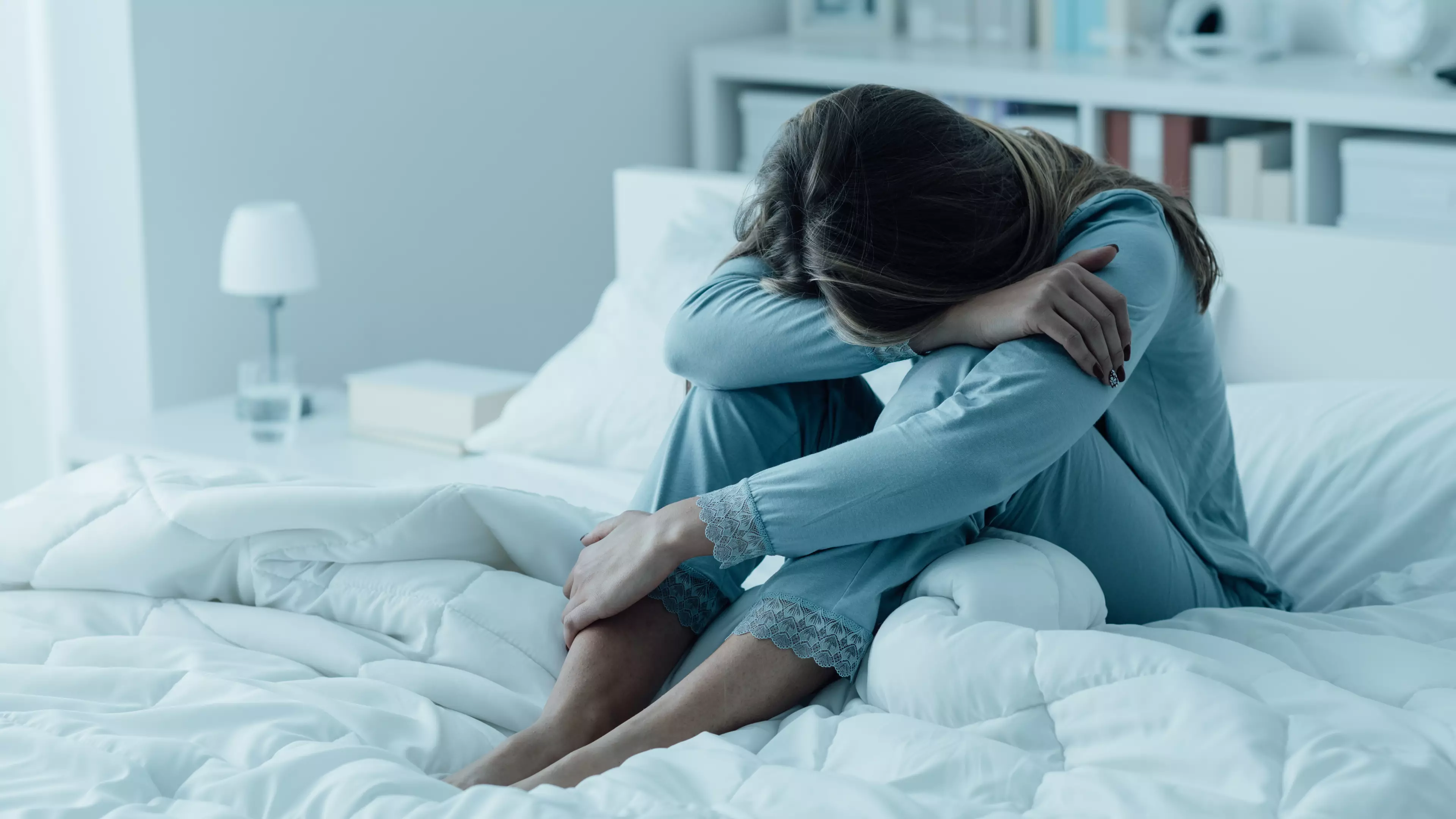
Last week, Victoria Cunningham's family were left "worried sick".
She had been on holiday in Portugal, but after she was too intoxicated to board the plane home from Faro Airport with her partner, she dumped her passport and completely disappeared.
Thanks to her brother John Whaite's platform as a Great British Bake Off winner, it wasn't long before Victoria's disappearance became headline news and a nationwide social media campaign to find her began.

She'd been sleeping on a bench outside the airport before going missing, with John claiming that her poor mental health meant she often "goes on binges of drink and drugs and during which she will often show signs of self harm and threaten and attempt suicide".
Advert
Luckily, she was found by a stranger three days after her original flight was meant to take off.
John added that she was "alive and sober, but immensely distressed," and gravely informed concerned members of the public that her recovery had happened "just in time".
While Victoria's struggle shocked the nation, the cause of her breakdown was PMDD, a little-known premenstrual disorder that affects as many as one in 20 women worldwide every month.
Advert
Explaining the condition, Dr Tory Eisenlohr-Moul, a psychologist specialising in premenstrual disorders and chairman of the IAMPMD clinical advisory board, told Pretty 52: "PMDD is a severe, abnormal reaction to normal hormone changes across the menstrual cycle.
"Although it can include physical symptoms, emotional symptoms are the core of PMDD, including anger and irritability, anxiety, mood swings, and depression. Symptoms start around the time of ovulation, and continue through the onset of menses."
Also known as premenstrual dysphoric disorder, the condition is not dissimilar to PMS, but for some can end up being far more serious, debilitating women and individuals with a female reproductive system for the week or two ahead of their periods.
Tragically, a massive 30 per cent of the 6 million with PMDD attempt to take their lives at least once.
Advert
"You just want to escape your own hell"

Victoria's struggle is all too familiar for Samantha Carter, 29, who claims the condition has made aspects of her daily life "completely impossible" over the past 15 years.
Telling Pretty 52 how she felt when she heard Victoria's story, she said: "It was heartbreaking. Living with PMDD you want to escape. You want to escape the noise, the lights, and the judgmental stares. Your mind is telling you the world is against you.
Advert
"You don't care about anything in the moment, you just want to escape your own hell."
Over the years, Samantha's PMDD has affected her work life, her relationships and her ability to look after her children. In a fit of rage she almost punched a co-worker, and she frequently has to miss shifts because of her mental state.
"On the really bad days I have to ask someone to take my children just so I know they get fed, because I don't even have the strength to do that," she added. "The isolation has caused me to cancel plans with my friends and family multiple times."
While some of Samantha's friends have tried to understand her condition, she's lost others, who claim she's just "being dramatic and wanting attention" - a bitter reminder of the lack of understanding surrounding PMDD.
Advert
Samantha's mood swings have also put a strain on her marriage, to the point where she's even tried to make her husband leave her during the "hell weeks".
She emotionally reflected: "He does sometimes fight back when I am in an episode, but who can blame him? He catches the wrath of my PMDD, and he defends himself when I get downright nasty. But, when it's all over he is still standing there loving me the same way he did on the day we got married."
Things have got so tough that she once found herself among the 30 per cent of sufferers who felt like they couldn't go on, ending up in a mental hospital for a week after tragically making a suicide attempt.
For Samantha, a combination of hormone altering Gonadotropin analogue injections, antidepressants and mood stabilisers have helped her to manage her condition.
"I had very upsetting thoughts that were frightening"

For PMDD podcast host Sarah Williams, 48, it wasn't until she had a hysterectomy later in life that she found any solace from her condition.
Despite being given no official diagnosis until she was 42, Sarah experienced symptoms of PMDD persistently since she was at school, displaying itself through "inconsistencies" in her mood, an inability to concentrate and "episodes of rage, conflict and distressing behaviour."
"As I became unable to be consistent in my attitude in school and my completion of school work I fell behind in my achievements and underperformed," she recalled. "Low mood was present monthly, often with sudden onset the day before my period and very upsetting thoughts that were frightening.
"One half of the month I would feel sociable but the other lose all interest. This lack of consistency made taking up any kind of regular class or activity difficult, or even just committing to a regular night out with the girls."
While these symptoms followed Sarah for much of her adult life, as is frequently the case, she felt her condition worsen as she entered peri menopause in her late 30s.
This physical change occurred at the same time Sarah was moving into a more senior role at work, but due to her "erratic, unpredictable," mood and "over sensitive" behaviour for two weeks of every month, she was eventually forced to quit her job.
"I seemed to be on a never-ending roundabout of symptoms," Sarah reflected. "I just felt unable to cope".
While small things like tracking her symptoms on an app, SAD light therapy and taking mood enhancing supplements helped her to some degree, like Victoria, Sarah admits she sometimes used to self-medicate in more destructive ways, using alcohol and cigarettes to cope.
She too credits SSRI medication for helping to manage her anxiety and hormone injections for reducing the symptoms, but as an extreme case, eventually decided with the guidance of doctors that a hysterectomy with bilateral oophorectomy (removal of the ovaries) was her only option.
"On a personal note, sometimes it is only through reading other people's experiences that the gravity of the effects of PMDD on my own life hit home," she reflected.
"I felt a huge amount of empathy with Victoria having experienced many periods like this. I hope Victoria is supported to have the best treatment plan for her as soon as possible. There is great benefit to other people with PMDD that her brother has raised a huge amount of awareness as a result."
"It's like a hurricane that sweeps through your life"

Emily Grace, 29, was diagnosed with PMDD three years ago, after suffering with mental health since the onset of puberty, aged just 11.
As her PMDD kicked in monthly, Emily's anxiety would "sky rocket".
"I would become very distressed, and turn to very unhealthy coping mechanisms, such as deliberate self harm, in order to try and manage these feelings," she recalled. In the week following, she would become "plagued with guilt" over her actions.
"It became a downward spiral," she added. "I often used to say that PMDD was like a hurricane that sweeps through your life on a monthly basis, at the epicentre it destroys everything in sight, as the storm begins to pass the clear up process begins, but before long the storm has returned and once again you are caught up in it and spiralling back into self destruction."
Like Sarah and Samantha, as she grappled with her condition, all aspects of Emily's life suffered as a result.
She was forced to change jobs, take a career break and eventually quit working altogether as her symptoms became too much. While her friends now understand the condition, she admits they used to take the brunt of her struggle.
"I think when you are in the depths of emotional despair you can tend to take your distress, frustration and agitation out on those who are closest to you," she said.
At first, Emily's loved ones and even health professionals tried to pass her monthly symptoms as something that would naturally "get better," but it eventually became more and more obvious something needed to be done.
Despite her reasonably recent diagnosis, Emily claims there was very little awareness of the condition when she was trying to get to the root of her issues.
"A friend had told me about PMDD a few years prior to my diagnosis, but I was very naïve as to what such a condition actually entailed," she said. "I once questioned if my mental health difficulties could be linked to my reproductive cycle, however at the time there was very little awareness of premenstrual disorders."
After trying everything, Emily too decided that a hysterectomy with bilateral oophorectomy was the only option for her, although she was under no illusion about the gravity of her decision.
"I would be keen to stress that this is only final stage treatment," she said. "It is not by any means a "quick fix. Surgery, infertility and surgical menopause all come with many of their own challenges".
Discussing Victoria's public struggle, she said: "I could relate so much to the distress, struggle and pain she must have been feeling at the time to react as she did.
"PMDD can be such a scary and isolating illness...I just wanted to reach out to her, and tell her that she was such a strong woman, that she wasn't alone and that things would eventually get better."
What to do if you think you're suffering from PMDD

- Track your symptoms
At the very first sign that you might be suffering from PMDD, tracking your symptoms and getting to know your cycle is a great place to start. Many period tracking apps specifically tailored to the condition, such as Me V PMDD, creates graphs which tracks your symptoms and notice patterns month on month.
- Visit your doctor
Your doctor or mental health practitioner will be able to best determine the course of treatment right for you.
- Get informed
After visiting your doctor, for more information on PMDD, visit Vicious Cycle: Making PMDD Visible on Facebook. Run by a team of volunteers who have all suffered from PMDD themselves, the page's aim is to act as a hub to "signpost people to help and support". You can also visit IAPMD here, where a whole range of invaluable resources are available.
- Find your community
PMDD sufferers can often feel very alone, but the first thing to remember is there is a community out there who can relate to your struggle. You can find a whole host of individuals using the hashtag #PMDDPeeps on Twitter. Plus, the IAMPD website offers links to peer support.
- Seek treatment
As discussed above, there are a whole array of treatments available for PMDD sufferers.
For some, seeing a councillor may help with symptoms such as anxiety and depression. You may also be offered antidepressants, and for some combined contraceptives can help manage the condition.
In more severe cases, hormonal (GnRH) analogue injections are available to bring on a temporary menopause, and finally a total hysterectomy (an operation to remove your uterus) with bilateral salpingo-oophorectomy (an operation to remove your ovaries and fallopian tubes) will be offered when all other avenues have been pursued.
Featured Image Credit: Shutterstock